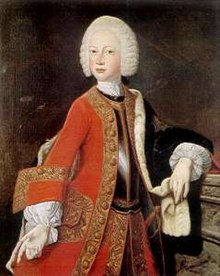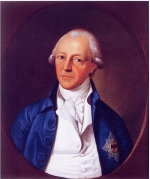Alexander (Brandenburg-Ansbach-Bayreuth)
Christian Friedrich Carl Alexander von Brandenburg-Ansbach (* February 24, 1736 in Ansbach ; † January 5, 1806 in Benham Palace near Speen in England) was the last margrave of the two Franconian margravates of Brandenburg-Ansbach (since 1757) and Brandenburg-Bayreuth ( since 1769) from the house of the Hohenzollern family . The Friedrich-Alexander-Universität Erlangen-Nürnberg , which he sponsored significantly, is partly named after him.
Life
Origin and family
His parents were Margrave Karl Wilhelm Friedrich of Brandenburg-Ansbach and Friederike Luise of Prussia , daughter of King Friedrich Wilhelm I and sister of Friedrich II , as well as Margravine Wilhelmine of Bayreuth .
After the sudden death of his older brother Karl Friedrich August on May 9, 1737, he became the Hereditary Prince of the Principality. From 1748 to 1759 he studied in Utrecht . As a young Count of Sayn (the county of Sayn-Altenkirchen in the Westerwald fell to the Principality of Ansbach as early as 1741) he made a trip to Turin and Savoy . It is unclear whether he contracted syphilis during this trip . In any case, despite two marriages and several relationships, Alexander remained childless. On November 22, 1754, he married in Coburg Friederike Caroline von Sachsen-Coburg-Saalfeld (1735–1791), daughter of Duke Franz Josias .
On August 3, 1757 he became sovereign of Brandenburg-Ansbach. The principality's residence was in Ansbach, but Alexander preferred to stay at his hunting and country residence in Triesdorf . There the so-called White Castle for his lover Hippolyte Clairon , the Red Castle as his home and the Villa Rotunda for his mistress and later wife Elizabeth Craven were rebuilt or rebuilt.
Economy and military
In 1758 he founded the porcelain factory in Ansbach and started farming by importing sheep .
In 1780 Alexander founded his own bank, the Hochfürstlich Brandenburg-Anspach-Bayreuthischen Hofbanco , which merged as the Bayerische Staatsbank with the Bayerische Vereinsbank (today HypoVereinsbank ). He no longer wanted to leave the financial affairs to foreign banks, but instead wanted to keep the income to himself as a private banker .
He achieved income, among other things, by renting auxiliary troops to the British king for his colonies in America. These were involved in the northern campaign under General Howe in New York and others under the command of General Cornwallis in the battle of Yorktown .
In nominal terms, Alexander was chief of the Franconian district dragoon regiment with command of the 1,644-strong leased Franconian army , of which 1,183 men returned home in 1783. The margrave rented further troops to Holland . With the income he paid off the national debt, which had amounted to five million guilders when he took office; when he abdicated 30 years later, the debt was only 1.5 million guilders.
Secret treaty for the sale of the principalities to Prussia
In 1769, the Principality of Bayreuth also fell to Alexander in accordance with the Hohenzollern House and Imperial Laws. Alexander ceded his principalities to Prussia in a secret treaty on January 16, 1791 , as he was childless and Prussia would have become heir anyway after his death (passage in the Treaty of Teschen of May 13, 1779). The contract was arranged by Minister Karl August Freiherr von Hardenberg , who had been active in Ansbach since 1790 . According to the contract, Prussia paid the margrave an annual annuity of 300,000 guilders as compensation and incorporated the two principalities as the administrative area of Ansbach-Bayreuth into his dominion. So these Franconian regions became Prussian. On December 15, 1805, after the Treaty of Schönbrunn , the Principality of Ansbach fell to France in exchange for the Electorate of Hanover and passed to the Kingdom of Bavaria in 1806 , and the Principality of Bayreuth in 1810.
Christian Friedrich Carl Alexander was an honorary member of the Royal Academy of Sciences .
After Alexander's first wife Caroline Friederike died on February 18, 1791 in Unterschwaningen , where she had lived after the separation from the margrave, he left Triesdorf on May 19 of the same year for Great Britain. On October 30, 1791, in Lisbon , he married Lady Elizabeth Craven , daughter of Augustus Berkeley, 4th Earl of Berkeley and widow of William Craven. Her first husband, the 6th Baron Craven, had died shortly before. On December 2, Alexander signed his abdication in Bordeaux . He went to England as a private citizen with his second wife and devoted himself to horse breeding . In December 1791 he bought a property near Hammersmith on the Thames, in 1798 he acquired Benham Estate. On January 5th, 1806 Alexander died after a short illness "affecting the lungs". A plaque in St. Mary's Church in Speen near Newbury commemorates the "Margrave of Brandenbourg, Anspach and Bareith".
literature
- Elfi M. Haller: Margrave Alexander - Franconia's last Hohenzollern prince ( Bavaria Antiqua ), Bayerische Vereinsbank, Munich 1980.
- Susan Richter : On the temptation to live oneself - The abdication of Margrave Friedrich Carl Alexander von Ansbach-Bayreuth in 1791 against the background of the legal status change from public to private. In: Dies./Dirk Dirbach (ed.): Renunciation of the throne. The abdication in monarchies from the Middle Ages to modern times. Cologne / Weimar / Vienna 2010, ISBN 978-3-412-20535-5 , pp. 95-122.
- M. Spindler, A. Kraus: History of Franconia up to the end of the 18th century . Munich 1997, ISBN 3-406-39451-5 .
- Arno Störkel: Christian Friedrich Carl Alexander: The last Margrave of Ansbach-Bayreuth . Ansbach 1995, ISBN 3-925649-02-6 .
- Gerhard Taddey (ed.): Lexicon of German history . Events, institutions, people. From the beginning to the surrender in 1945. 3rd, revised edition. Kröner, Stuttgart 1998, ISBN 3-520-81303-3 .
- Siegfried Hänle: Alexander (Margrave of Brandenburg-Ansbach-Bayreuth) . In: Allgemeine Deutsche Biographie (ADB). Volume 15, Duncker & Humblot, Leipzig 1882, pp. 264-266.
Web links
- Triesdorf, residence of the last margrave of Ansbach-Bayreuth
- For the 200th anniversary of death
- Tripota - Trier portrait database
References and comments
- ↑ contemporary Alexander or CFC Alexander . The arbitrary name given by Karl Alexander, which is sometimes encountered in literature, is an invention of Prussian historiography in the later 19th century.
- ↑ Max von Eelking : The German Allied Troops in the North American War of Independence, 1776–1783. Translated from German by JG Rosengarten . Joel Munsell's Sons, Albany, NY., 1893, p. 105, LCCN 72-081186 .
- ↑ Eelking, Max von: The German Allied Troops in the North American War of Independence, 1776–1783. Translated from German by JG Rosengarten . Joel Munsell's Sons, Albany, NY., 1893, pp. 203, 209, 214, LCCN 72-081186 .
- ^ Lowell, Edward J: The Hessians and the other German Auxiliaries of Great Britain in the Revolutionary War . Harper & Brothers, Franklin Square, New York, 1884, p. 277, LCCN 02-004604 .
- ↑ cf. List of regiments of the Frankish Reichskreis
- ↑ www.historisches-lexikon-bayerns.de (PDF; 5.25 MB).
- ↑ www.historisches-lexikon-bayerns.de: House contracts of the Zollern / Gera house contract 1598 .
| predecessor | Office | successor |
|---|---|---|
| Karl Wilhelm Friedrich |
Margrave of Brandenburg-Ansbach 1757–1791 |
Friedrich Wilhelm II., King of Prussia |
| Friedrich Christian |
Margrave of Brandenburg-Bayreuth 1769–1791 |
Friedrich Wilhelm II., King of Prussia |
| personal data | |
|---|---|
| SURNAME | Alexander |
| ALTERNATIVE NAMES | Christian Friedrich Carl Alexander |
| BRIEF DESCRIPTION | Margrave of Brandenburg-Ansbach and Brandenburg-Bayreuth |
| DATE OF BIRTH | February 24, 1736 |
| PLACE OF BIRTH | Ansbach |
| DATE OF DEATH | January 5, 1806 |
| Place of death | Benham Castle near Speen, Berkshire |









